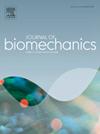设定停止距离内步态终止的生物力学分析:一项初步研究
IF 2.4
3区 医学
Q3 BIOPHYSICS
引用次数: 0
摘要
在限制停止距离的条件下,步态终止包括一个关键的运动任务,其中精确的平衡控制和协调是防止跌倒或碰撞的先决条件。尽管有一些关于步态终止的研究,但在非计划步态终止过程中具体的生物力学效应仍未得到充分探讨。为了深入了解具有挑战性条件下的自适应运动控制策略,例如突然停止,我们确定了健康年轻人在有限距离内步态终止时的生物力学适应趋势。这项横断面研究包括12名健康的年轻人。参与者被指示遵循一条指导线来控制步行速度(在舒适速度的100%和125%),并在距离骨盆标记物1.75或1.5倍腿长(从髂前上棘到内踝测量)的新红线前停下来。三维运动分析和力板数据用于评估关键的生物力学参数。以速度和距离为变量,对每个参数进行双向重复测量方差分析。在参与者中[年龄,平均(SD): 22.4(3.1)岁],与较长的停车距离相比,较短的停车距离产生较小的前后(AP)最大力(推进力;P & lt;0.001),从出现的红线开始,第一步的事件时间(P = 0.02)以及AP最小力(制动;P & lt;0.001)和脚趾与第一步之间的时间间隔(P = 0.02)。因此,健康年轻人在适应受限停止距离时采用的生物力学策略有助于更好地理解受限步态条件下的运动控制和平衡。本文章由计算机程序翻译,如有差异,请以英文原文为准。
Biomechanical analysis of gait termination within set stopping distance: A pilot study
Under conditions of restricted stopping distances, gait termination comprises a critical motor task, wherein precise balance control and coordination are prerequisites to prevent falls or collisions. Despite several studies on gait termination, the specific biomechanical effects during unplanned gait termination remain underexplored. To provide insights into adaptive motor-control strategies under challenging conditions, such as abrupt stopping, we ascertained trends in biomechanical adaptations during gait termination within restricted distances in healthy young adults. This cross-sectional study included 12 healthy young adults. Participants were instructed to follow a guiding line to control walking speed (at 100 % and 125 % of comfortable speed) and stopped in front of an emerging red line at 1.75 × or 1.5 × the leg length (measured from the anterior superior iliac spine to the medial malleolus) from the pelvis marker. Three-dimensional motion analysis and force-plate data were used to evaluate key biomechanical parameters. Two-way repeated-measures analysis of variance, with velocity and distance as variables, was performed for each parameter. Among participants [age, mean (SD): 22.4 (3.1) years], short, compared to long, stopping distances generated smaller anteroposterior (AP) maximum forces (propulsion; P < 0.001) and reduced the event time at the first stepping from the emerging red line (P = 0.02) as well as the AP minimum force (braking; P < 0.001) and time interval (P = 0.02) between toe-off and first stepping. Thus, biomechanical strategies employed by healthy young adults in adaptation to restricted stopping distances facilitate a better understanding of motor control and balance under constrained gait conditions.
求助全文
通过发布文献求助,成功后即可免费获取论文全文。
去求助
来源期刊

Journal of biomechanics
生物-工程:生物医学
CiteScore
5.10
自引率
4.20%
发文量
345
审稿时长
1 months
期刊介绍:
The Journal of Biomechanics publishes reports of original and substantial findings using the principles of mechanics to explore biological problems. Analytical, as well as experimental papers may be submitted, and the journal accepts original articles, surveys and perspective articles (usually by Editorial invitation only), book reviews and letters to the Editor. The criteria for acceptance of manuscripts include excellence, novelty, significance, clarity, conciseness and interest to the readership.
Papers published in the journal may cover a wide range of topics in biomechanics, including, but not limited to:
-Fundamental Topics - Biomechanics of the musculoskeletal, cardiovascular, and respiratory systems, mechanics of hard and soft tissues, biofluid mechanics, mechanics of prostheses and implant-tissue interfaces, mechanics of cells.
-Cardiovascular and Respiratory Biomechanics - Mechanics of blood-flow, air-flow, mechanics of the soft tissues, flow-tissue or flow-prosthesis interactions.
-Cell Biomechanics - Biomechanic analyses of cells, membranes and sub-cellular structures; the relationship of the mechanical environment to cell and tissue response.
-Dental Biomechanics - Design and analysis of dental tissues and prostheses, mechanics of chewing.
-Functional Tissue Engineering - The role of biomechanical factors in engineered tissue replacements and regenerative medicine.
-Injury Biomechanics - Mechanics of impact and trauma, dynamics of man-machine interaction.
-Molecular Biomechanics - Mechanical analyses of biomolecules.
-Orthopedic Biomechanics - Mechanics of fracture and fracture fixation, mechanics of implants and implant fixation, mechanics of bones and joints, wear of natural and artificial joints.
-Rehabilitation Biomechanics - Analyses of gait, mechanics of prosthetics and orthotics.
-Sports Biomechanics - Mechanical analyses of sports performance.
 求助内容:
求助内容: 应助结果提醒方式:
应助结果提醒方式:


